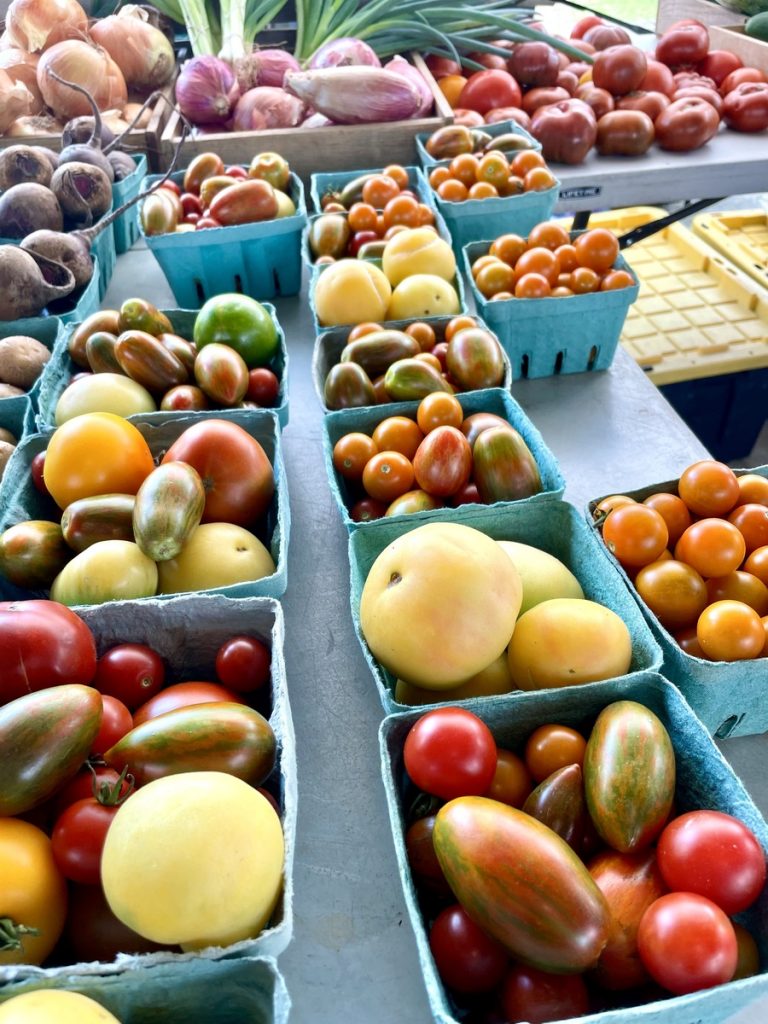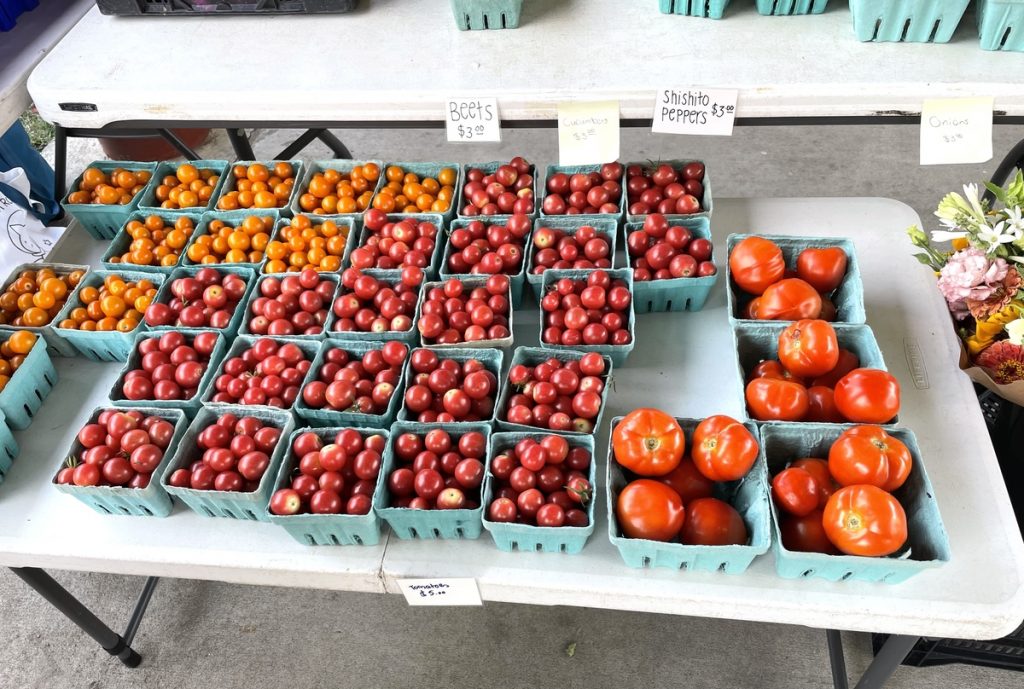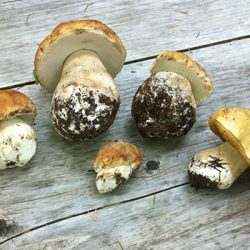

Here we are in midsummer and tomatoes are reaching peak ripeness. Soon they will just be a memory. We caught up with Philadelphia-based chef and cookbook author April McGreger while she was waiting for her first tomatoes to ripen. McGreger shares her favorite ways to enjoy summertime tomatoes—including her recipe for a simple and compelling tomato paste to preserve the height of summer flavor. McGreger is the author of Jam On! All There is to Know about Canning & Preserving, to be published in September. —Elaine Kim Heide
My tomatoes usually hit their stride near the end of July. In my kitchen that means stacks of tomatoes in all their glorious colors and forms—eaten with either a big glug of my best olive oil or homemade garlic mayo and flaky sea salt. Or tomato sandwiches and BLTs on spongey yet crusty bread—I often make Carolina Gold Rice Bread, my ideal tomato bread, to celebrate peak tomato season. Then I’m ready for salads like panzanella with chunks of torn rustic bread absorbing the juicy tomatoes and generous handfuls of basil.
When I have more tomatoes that I can eat raw, I am finally ready to cook them. The first thing I make is Pasta Stromboli. My idea of tomato sauce was changed forever the summer that I spent on the Aeolian island of Stromboli, off the coast of Sicily. I was there to study geology—gathering seismic data which would be the basis for my master’s thesis—but it was the rich food culture of this tiny, isolated island that captured my imagination. At the market in the village, deep-red cherry tomatoes hung from the rafters by their four-foot brown stems.
The tomatoes were sold semi-dried, following an old Sicilian tradition of hanging small cherry tomatoes outside in the sun for three to four days after harvest to concentrate their flavors. My Italian colleagues turned these tomatoes into the quickest, easiest, most succulent pasta sauces that I had ever eaten. If you live in a fairly dry climate or it’s just a particularly dry week, you can clip a few stems loaded with cherry tomatoes—my favorite variety on the east coast are Sungolds—and hang them to dry in the sun for a few days. But even straight off the vine they are pretty perfect. This is a pasta dish that is absolutely all about the quality of the tomatoes so I don’t bother trying it with supermarket tomatoes.
I definitely gravitate towards heirloom tomatoes, with Green Cherokee and Brandywine varieties being two of my favorites. However, I always like to include some classic, high-acid deep-red field-grown Celebrity tomatoes as a contrast. The lightest dusting of sugar really puts them over the top. It should be so restrained that no one realizes it’s there. It’s just to bump the flavor even higher. I include bowls of homemade garlic mayo and another platter of Claudio’s mozzarella (from Philly’s Italian market) or I sometimes make my own mozzarella from the grass-fed cow’s milk from Oasis Creamery in Southeastern PA.
When eating outside, a big bowl of Pasta Stromboli will round out the menu and makes the young ones happy. Give me something vibrant and alive with nice acidity and aroma—for this meal, a Chianti. I set the food out family style, to be passed around a long dining table and lingered over elbow to elbow. On the east coast, a gentle fan keeps us cool and the bugs at bay.
For me, preserving each individual fruit or vegetable as it comes into season is a way to be truly present and sensually engaged in each particular moment in time. It’s grounding, ritualistic, and dynamic enough to hold my attention season after season. I also find it incredibly satisfying to take excess produce, which is perishable and fleeting, and turn it into something that is as utilitarian—and romantic—as summer tomato sauce. Each jar is a sun-kissed memory and a promise for the return of warmer weather and garden fresh produce.
There is nothing I love more than taking an ingredient that is completely taken for granted—like tomato paste—and bringing it back to its original glory. It’s a culinary secret weapon to have at your fingertips. A few tablespoons and a splash of pasta water turn spaghetti into a silky, vibrant supper in minutes. I use it in soups, sauces, and rice dishes just like I would the canned stuff but with immensely better flavor. I’ve also been known to whisk a little into leftover pickle juice and spices for an incredible Bloody Mary.
Italians understand that the best tomato pastes come from the finest tomatoes. My favorite paste tomato to grow here in Philadelphia is the Amish Paste tomato. I underplant it every year, and it is hard to find, even at farmers’ markets. I usually just look for the field-grown, vine-ripened plum or Roma tomatoes if I can’t find more Amish pastes.


Ingredients
Tomato Passata
- 20 pounds red, ripe plum or paste tomatoes
- 1 stalk fresh basil (optional)
- 2 teaspoons canning salt
- 1 ¼ teaspoons citric acid, if canning
Instructions
- Wash tomatoes. Remove any large cores from the tomatoes and quarter them. Heat a large, wide stainless steel or ceramic-lined pot over low to medium heat, add quartered tomatoes and simmer, uncovered, for 30 minutes, stirring occasionally.
- Press the tomato mixture in batches through a food mill into a large bowl. Discard the peels and seeds and return the tomato mixture to your pot.
- Add the stalk of basil, salt, and, if you plan to can, the citric acid. If you choose to preserve your passata by freezing, then the addition of citric acid is not necessary.
- Simmer over low heat, stirring and scraping the bottom of the pot occasionally. Cook until thick and reduced by half, about 1 ½ hours.
- Remove the stalk of basil, plus any large leaves that may have broken off. You now have passata ready to be used in other recipes or canned or frozen for longer storage.
TO CAN PASSATA
- Sterilize canning jars and lids in boiling water. Fill with hot passata, leaving a ½-inch of headspace. Run a sterilized chopstick through any visible air bubbles. Wipe rims. Top with 2-piece lids. Process pints for 35 minutes in a boiling water bath.*
- Turn off heat and remove canner lid. Let jars rest in the canner for 10 minutes before removing, to prevent siphoning.
- * For elevations above 1,000 feet, canning instructions must be adjusted for altitude.
TO FREEZE PASSATA
- Pack into freezer-safe containers, leaving a ½-inch headspace for pints and 1-inch headspace for quarts because the sauce will expand as it freezes. Attach lids, label, and freeze for up to six months
TURN YOUR PASSATA INTO TOMATO PASTE
- Makes 9-10 half pints
- Preheat your oven to 350 degrees F.
- If you are planning to can your tomato paste, make sure you add the citric acid in the original passata recipe before you reduce it to a paste. Divide your finished passata from step 5 above (which you’ve already reduced from your food-milled plum tomatoes) between two large, rimmed baking sheets.
- Place the baking sheets in the oven. Stir the paste and rotate the baking sheets every half hour so that the paste reduces evenly.
- Bake until the passata is reduced by half and the mixture is thick enough to mound onto a spoon without sliding off. The paste is done when it is shiny, a deep brick red, and there is no water separating or weeping around the edges.
TO CAN TOMATO PASTE
- Sterilize half-pint canning jars and lids in boiling water. Fill jars, leaving a ½-inch headspace. Run a sterilized chopstick through any visible air bubbles. Wipe rims. Top with 2-piece lids.
- Process in a boiling water canner for 45 minutes.* Turn off heat and remove canner lid. Let jars rest in the canner for 10 minutes before removing, to prevent siphoning.
- * For elevations above 1,000 feet, canning instructions must be adjusted for altitude.
TO FREEZE TOMATO PASTE
- Pack into freezer-safe containers, leaving a ½-inch headspace for 4- to 8-ounce containers because the sauce will expand as it freezes. Attach lids, label, and freeze for up to nine months. Alternatively, you can freeze the paste in ice cube trays, then transfer the frozen cubes to a freezer bag for up to nine months of freezer storage.
This recipe is published as part of our Regional Tasting Report on Tuscan Sangiovese.
This is a W&S web exclusive. Get access to all of our feature stories by signing up today.


















